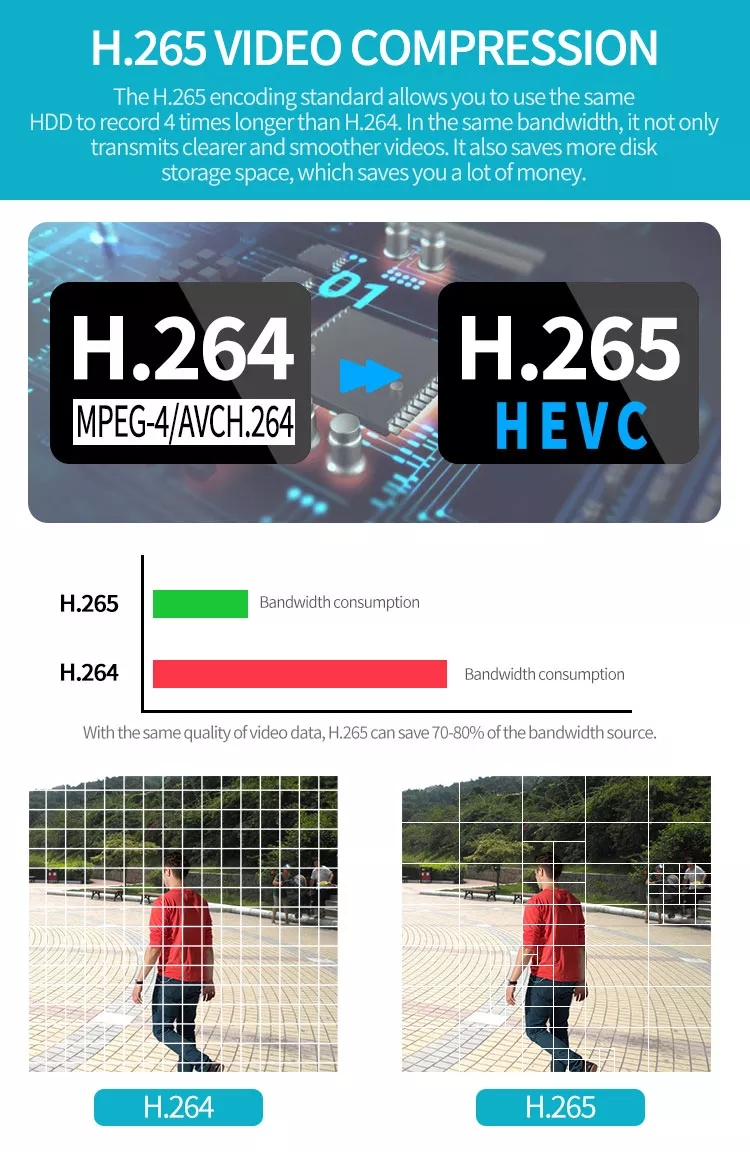The difference between DVR and NVR in video surveillance system
Practitioners who are new to the industry or want to enter the video surveillance system often encounter DVR and NVR, and often do not understand the difference and function of the two. Here I will briefly explain the function and difference between the two. 1. DVR: is the abbreviation of digital hard disk Tuya Nvr Wireless 4ch Cctv Camera System Kit video recorder, using hard disk as the storage carrier of video stream, converting the video stream output by analog camera into digital video stream storage, with network function, can realize network transmission. Cctv Network Wifi Camera
The device can work independently, which can store video stream and cooperate with monitor, keyboard and mouse to realize most common functions of video, such as: real-time browsing, historical playback, control operation (RS485 mode) and alarm processing. The video stream output by the analog camera is mainly SD, and the compression encoding method of the video stream is mainly H.264. The device is currently on the verge of obsolescence. Outdoor Ir Night Vision Security Cctv System
 2. NVR: is the abbreviation of network hard disk video recorder, and also uses hard disk as the storage carrier of video stream. It can only be connected to network video equipment, such as network cameras, DVR, and video server data; it is a video surveillance development process. The third generation of products is developed based on DVR. It is designed for positioning network itself, has network functions, and realizes network transmission. The device can work independently, which can store video stream and cooperate with monitor, keyboard and mouse to realize most common functions of video, such as: real-time browsing, historical playback, control operation and alarm processing. The access is digital video stream, which is also the mainstream device of the current video surveillance system. It is compatible with standard definition video stream and high-definition video stream, and many can also access 4K video stream. The compression encoding method of video stream supports H.264. and H.265 way.
2. NVR: is the abbreviation of network hard disk video recorder, and also uses hard disk as the storage carrier of video stream. It can only be connected to network video equipment, such as network cameras, DVR, and video server data; it is a video surveillance development process. The third generation of products is developed based on DVR. It is designed for positioning network itself, has network functions, and realizes network transmission. The device can work independently, which can store video stream and cooperate with monitor, keyboard and mouse to realize most common functions of video, such as: real-time browsing, historical playback, control operation and alarm processing. The access is digital video stream, which is also the mainstream device of the current video surveillance system. It is compatible with standard definition video stream and high-definition video stream, and many can also access 4K video stream. The compression encoding method of video stream supports H.264. and H.265 way.  Difference: From the introduction of the above two devices, we can already see the difference. The former is an analog access camera, which converts the analog video stream into a digital stream, realizes network transmission, and facilitates large-scale networking. ), the device is on the verge of obsolescence. The latter is developed on the basis of the former. At present, it is mainly connected to network cameras, and the former can also be connected. It is the mainstream device in the current market, which supports standard definition video and high-definition, and even ultra-high-definition video. The encoding method H.264 and H.265 modes are also supported. In addition, between the two, there have also been intermediate video devices between the two, that is, DVR and NVR, so sometimes some devices do not have strict boundaries, I hope beginners should understand more about the role of the device And the principle, can learn more with less effort. Let's introduce some other video surveillance knowledge. DVS: short for video server, the main function is to digitize analog video, in order to solve the needs of single-channel analog camera remote transmission or access to network video surveillance. The overall direction of future monitoring system development is: digitization, intelligence, automation, and networking. Networking is the general trend of monitoring systems, which greatly simplifies and improves the way and speed of information transmission. With the continuous development of network technology and computer technology and the gradual maturity of the market application environment, the network video monitoring system based on video switching technology has become the development direction of the monitoring system. It can be expected that the network video surveillance system will eventually completely replace the analog video surveillance system with its advantages that the analog video surveillance system cannot match, such as long-distance monitoring, good scalability and manageability, and easy integration with other systems. The new standard in surveillance systems.
Difference: From the introduction of the above two devices, we can already see the difference. The former is an analog access camera, which converts the analog video stream into a digital stream, realizes network transmission, and facilitates large-scale networking. ), the device is on the verge of obsolescence. The latter is developed on the basis of the former. At present, it is mainly connected to network cameras, and the former can also be connected. It is the mainstream device in the current market, which supports standard definition video and high-definition, and even ultra-high-definition video. The encoding method H.264 and H.265 modes are also supported. In addition, between the two, there have also been intermediate video devices between the two, that is, DVR and NVR, so sometimes some devices do not have strict boundaries, I hope beginners should understand more about the role of the device And the principle, can learn more with less effort. Let's introduce some other video surveillance knowledge. DVS: short for video server, the main function is to digitize analog video, in order to solve the needs of single-channel analog camera remote transmission or access to network video surveillance. The overall direction of future monitoring system development is: digitization, intelligence, automation, and networking. Networking is the general trend of monitoring systems, which greatly simplifies and improves the way and speed of information transmission. With the continuous development of network technology and computer technology and the gradual maturity of the market application environment, the network video monitoring system based on video switching technology has become the development direction of the monitoring system. It can be expected that the network video surveillance system will eventually completely replace the analog video surveillance system with its advantages that the analog video surveillance system cannot match, such as long-distance monitoring, good scalability and manageability, and easy integration with other systems. The new standard in surveillance systems.




